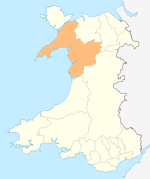Llanuwchllyn
| Llanuwchllyn | |
|---|---|
 Main street in 2007 | |
 Llanuwchllyn | |
| Llanuwchllyn shown within Gwynedd | |
| Population | 617 (2011) |
| OS grid reference | SH877299 |
| Community |
|
| Principal area | |
| Country | Wales |
| Sovereign state | United Kingdom |
| Post town | BALA |
| Postcode district | LL23 |
| Dialling code | 01678 |
| Police | North Wales |
| Fire | North Wales |
| Ambulance | Welsh |
| EU Parliament | Wales |
| UK Parliament | |
| Welsh Assembly | |

Llanuwchllyn is a village and community in Gwynedd, Wales, near the southern end of Bala Lake (Llyn Tegid). Its population according to the United Kingdom Census 2001 was 834,[1] of whom about 81% were Welsh-speaking.[2] The figures for the 2011 census were: population 617; Welsh speakers 82%.[3]
The parish church of St Deiniol is a Grade II* listed building.[4]
Llanuwchllyn railway station is the headquarters of the narrow gauge Bala Lake Railway, centred on the former Great Western Railway station on the standard-gauge line from Ruabon to Barmouth.
The village was the birthplace of Welsh language author and educationalist Owen Morgan Edwards.
Caer Gai, a Roman fort near Llanuwchllyn, was traditionally known as the home of Cei, the character in the Arthurian legend known in English as Sir Kay. Poets of the 15th century recorded a story, ultimately deriving from the Prose Merlin included in the Lancelot-Grail and the Post-Vulgate Cycle, that King Arthur and Cei were brought up at Caer Gai as foster brothers.[5] Caer Gai is also Grade II* listed.[6]
Governance
An electoral ward with same name exists. This ward also includes the community of Llangywer with a total population taken at the 2011 census of 877.[7]
Notes
- ↑ Llanuwchllyn Census 2001 National Office of Statistics
- ↑ Welsh-speaking statistics Welsh Language Board
- ↑ "Community population 2011 plus percentage of welsh speakers". Retrieved 17 May 2015.
- ↑ "Parish Church of St Deiniol, Llanuwchllyn". British Listed Buildings. Retrieved 17 December 2013.
- ↑ Bromwich, p. 311.
- ↑ "Caer Gai, including adjoining forecourt walls to the NE, Llanuwchllyn". British Listed Buildings. Retrieved 17 December 2013.
- ↑ "Ward population 2011". Retrieved 17 May 2015.
References
| Wikimedia Commons has media related to Llanuwchllyn. |
- Bromwich, Rachel (2006). Trioedd Ynys Prydein: The Triads of the Island of Britain. University Of Wales Press. ISBN 0-7083-1386-8.
